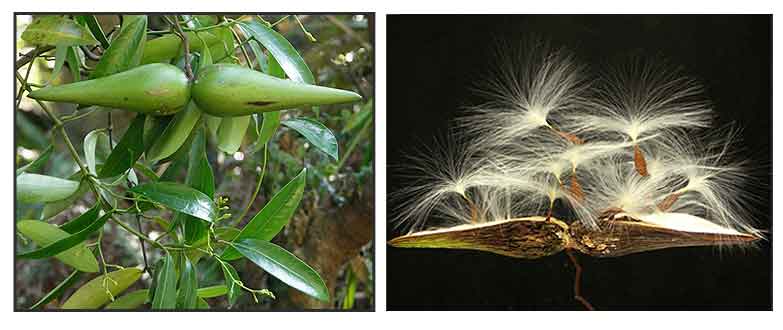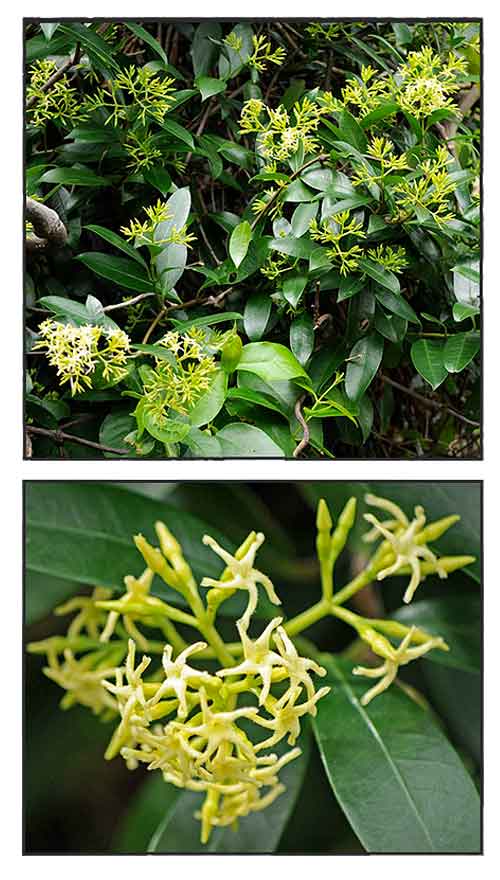
Family • Apocynaceae
Afine
Anodendron affine (Hook. & Arn.) Druce
ASIAN CABLE CREEPER
Shan teng
| Scientific names | Common names |
| Aganoma laevis Champ. ex Benth. | Afine (Tagalized) |
| Anodendron affine (Hook. & Arn.) Druce | Asian cable creeper (Engl.) |
| Anodendron affine var. effusum Tsiang | Loose flower anodendron (Engl.) |
| Anodendron affine var. pingienense Tsiang & P.T.Li | |
| Anodendron fangschengense Tsiang & P.T.Li | |
| Anodendron laeve (Champ. ex Benth.) Maxim. ex Franch. & Sav. | |
| Anodendron loheri Merr. | |
| Anodendron salicifolium Tsiang & P.T.Li | |
| Anodendron suishaense Hayata | |
| Epigynum laevigatum Hook.f. | |
| Holarrhena affinis Hook. & Arn. | |
| Anodendron affinie is an accepted species. KEW: Plants of the World Online | |
| Other vernacular names |
| CHINA: Shan teng, Bu hia tin. |
| JAPANESE: Sakakikazura. |
| VIETNAM: Nga voi, Day duy, Töc thang. |
• Anodendron affine is an evergreen woody vine inhabiting evergreen tree forests. Branches are green at first, then turn dark purple. Leaves, leathery and glossy, are of opposite phyllotaxis; blades measure 5-10cm in length, 1-3cm in width, and are oblong with entire margins. This plant bears cymes at the end of the branches with many light yellow flowers. Corollas, measuring 0.8-1cm, are in a high cup shape and are cleft in 5 twisted segments. Bloom time: April-June. (2)
Constituents Properties Studies Availability |
May 2025
![]()
 |
| PHOTOS / ILLUSTRATIONS |
| IMAGE SOURCE: Asian cable creeper - Anodendron affine / MACAO NATURE - Macao Biological Database / 2 photos / Non-commercial use / Click on image or link to go to source page / Macao Nature |
| OTHER IMAGE SOURCE:Apocynaceae : Anodendron affine / Inflorescence / Copyright © 2011 by Leonardo L Co [ref. DOL33558] / Non-Commercial Use / Image modified / Click on image or link to go to source page / Phytoimages.siu.edu |
| OTHER IMAGE SOURCE:Apocynaceae : Anodendron affine / Flowering plant / Copyright © 2011 by Leonardo L Co [ref. DOL33560] / Non-Commercial Use / Image modified / Click on image or link to go to source page / Phytoimages.siu.edu |
Additional
Sources and Suggested Readings |
• |
DOI: It is not uncommon for links on studies/sources to change. Copying and pasting the information on the search window or using the DOI (if available) will often redirect to the new link page. (Citing and Using a (DOI) Digital Object Identifier) |
| List of Understudied Philippine Medicinal Plants |
| New plant names needed The compilation now numbers over 1,500 medicinal plants. While I believe there are hundreds more that can be added to the collection, they are becoming more difficult to find. If you have a plant to suggest for inclusion, native or introduced, please email the info: scientific name (most helpful), local plant name (if known), any known folkloric medicinal use, and, if possible, a photo. Your help will be greatly appreciated. |
• |
 |


 Distribution
Distribution